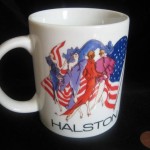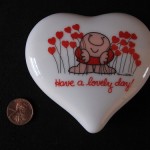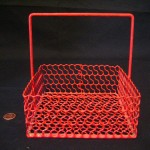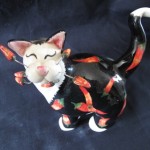A March 2011 story in the Los Angeles Times suggested that Significant Objects may be the literary vanguard of a trendy branding strategy.
Here are a few other press mentions:
ON THE AIR
Hear one or the other Significant Objects co-founder (but never both at once!) interviewed:
- On NPR’s All Things Considered.
- On WFMU, Benjamen Walker’s Theory of Everything
- On WNYC, The Brian Lehrer Show
- On CBC, Spark. Plus: Sheila Heti reads Cape Code Shoe!
- On WYPR, Maryland Morning — includes both Lizzie Skurnick (Pen Stand) and Laura Lippman (Motel Room Key) reading their stories!
- On New Hampshire Public Radio’s Word of Mouth.
- On WNPR/Connecticut’s Where We Live.
IN THE PRESS
Rob Walker and Josh Glenn were able to conduct one of the most life-affirmingly cheeky studies I have seen for ages… This wasn’t a scientific experiment, although it would be astonishing if some goateed PhD student wasn’t even now imitating the study in lab conditions with a proper control — and thereby sucking all the blood out of this particular orange. — “Brain Food” columnist Aditya Chakrabortty
Paper Cuts (New York Times Book Review):
Looking for a nice literary artifact? Edith Wharton’s letters — a packet sold at auction for more than $180,000 last month — may be out of reach, but collectors willing to settle for Lydia Millett’s chili cat figurine or Kurt Andersen’s Santa nutcracker will find plenty of bargains over at the new Web site Significant Objects. The idea, dreamed up by [Joshua Glenn and Rob Walker], is simple: invite several dozen authors to make up interesting stories about random objects picked up at thrift shops, post them on eBay, and let consumer fetishism take it from there.
Walker said it’s not a rigorous study. But he’s modest. SignificantObjects.com tells us that stories add value. It tells us that stories add value even when we know the story is manufactured. Indeed, a few days after I spoke with Walker he e-mailed to mention that the better known his project is becoming, “the more valuable, in theory, any object that was part of it might become.” In other words, the fabrication of a story about the object becomes a part of the story we tell. And a red wooden mallet, which sold for $71 (not to me), is no longer just another red wooden mallet.
Couch Surfer (The Independent of London):
If this is a cynical marketeer’s scam, rather than a mildly romantic social experiment, then consider me conned. Significant Objects combines one of the oldest of all media — the near-improvised short story — with the reinvigorated writer-reader relationship afforded by Web 2.0. What a thrill to be the nominal owner of a tale told by a favourite author, and to possess the very thing that inspired them — even if that significant object is too darned ugly for any sensible person’s mantelpiece.
More Intelligent Life (Economist):
The first volume of “Significant Objects”, which debuted over the summer, swiftly proved Messrs Walker and Glenn’s theory that stories add immeasurable value to objects. So for the second volume, they have “decided to do something useful with the information,” Walker says. This time proceeds will be donated to 826 National, a non-profit that tutors young people in writing and storytelling.
It’s an idea that writers adore: the notion that a good story can impart value to an insignificant object. Already desirable or at least useful objects … can obviously have their value increased through a robust back story. (It’s called advertising.) But what about objects that are undesirable? That are poorly made, useless or ugly? Can they ever become valuable or sellable? To those who don’t believe in the transcendent power of a good story … behold: the Significant Objects project.
How much would you pay for a nutcracker James Dean used — precisely how, we can’t guess — to pleasure himself? Or a cow-shaped creamer that once belonged to Norman Rockwell during a particularly dark period of his life? Neither of those things exists, actually. But that’s not the point. Rather, it’s this: what gives an object its worth? Is it simply the cold calculus of market value? Or is it the irrational, talismanic properties with which we humans sometimes imbue our most random inanimate possessions?
Freakonomics (New York Times):
Would you pay more … for a Sanka ashtray if Luc Sante made up a story about it? Apparently at least a few people would, as Joshua Glenn and Rob Walker found when they launched a project called Significant Objects, where they paired up creative writers with objects bought at garage sales and asked them to make up a story about the objects. Each object is for sale on eBay, where anyone can bid for it. So far, a Candyland labyrinth game bought as a thrift shop for $0.29 — with a story about it written by Matthew Battles — now has a top bid of $9.50. Does that supersonic premium reflect the quality of Battles’s story, the value of participating in an interesting project, or perhaps some new Candyland scarcity?
Jacket Copy (Los Angeles Times):
Can a good story make something more valuable? What if it’s entirely untrue? And what if the person telling the story — like, say, a novelist — is a kind of professional liar; does a professional lie give an object more value? And, hey, what if you could buy something like that on EBay? When authors Rob Walker (Buying In) and Joshua Glenn (Taking Things Seriously), each of whom is curious about the meaning and value we assign to objects, met in Boston [last summer], they came up with the idea for the fiction-auction project Significant Objects. Well-known literary authors — including Luc Sante and Lydia Millet — write a short story that serves the description for a basically worthless object that is then auctioned on EBay. The first set of auctions has closed, and while the ending prices were all less than $30, Walker points out that with listing prices beginning as low as 29 cents, the final value increased by as much as 4,000%. (Q&A with Josh Glenn)
It’s hard to figure out what makes something valuable, at least in the financial sense. Factors such as craftsmanship or scarcity may come into play, but material worth can also be linked to the story behind the object — a piece of used gum isn’t going to cost much, for example, yet if it was chewed by Michael Jackson right before he died, it might very well get sold at auction for thousands of dollars. Rob Walker, the New York Times Magazine‘s Consumed columnist and author of Buying In, and Joshua Glenn, who [edited] Taking Things Seriously, have recently teamed up to create Significant Objects, an online experiment in creating value from mostly useless trinkets through the medium of short fiction.
The Significant Objects Project is one designed to back up the idea that what would typically be considered a meaningless object — or, well, junk — can be made significant or valuable when it has a story behind it…. Check out SignificantObjects.com. You’re sure to get caught up in the well-written, cute and touching stories behind each plastic hot dog or “small stapler.” You may even decide to buy something. Consider it an investment.
Come for the fiction about knickknacks. Stay for the auctions that benefit writing programs.
You may miss out on the JFK bust, but there’s still time for the toy hot dog and necking team button! So bid…. Glenn and Walker have recruited a whole slew of big brains for the project, including Stewart O’Nan, James Parker, and Kurt Andersen.
The Significant Objects project aims to ascertain the market value of the written word. Authors are invited to buy an item from a junk shop, write a story about it, then advertise both object and story on eBay, the online auction site. A bust of J F Kennedy, for example, bought for $2.99 sold for $26.
The New York Times points us to Signifcant Objects, a little project they’ve affectionately called “a literary garage sale.”
SFGate (San Francisco Chronicle):
A kind of real-world laboratory for looking at the way we place value on things…. In a way, [Susan Clements, winning bidder for several SO auctions] says, it doesn’t really matter that the objects’ significance is made up. “If the writing moves me, it kind of melds with the object,” she says, “They sort of become one thing.” Clements’ explanation of ascribing value to these seemingly arbitrary objects turns out to be textbook support for one of Walker’s theories about the whole venture: “The funny thing is, whatever the real story of that fop figurine is, it’s been completely obliterated…. Whoever really designed it, whatever they really had in mind, whatever their real target market was, whatever meanings preceded — all that has been obliterated in a matter of a few hours. It enters into this new ecosystem, and the meaning comes out the other side, and it’s completed by the buyer.”
Concocted by American authors Joshua Glenn and Rob Walker, who have both written about the relationships people have with their possessions, Significant Objects poses a simple question: How much of an object’s value comes from its history?
Significant Objects is an incredibly fun, if curious, success, one that toys with the disparity between an object’s financial and emotional values, and speaks to our wonderfully human propensity to believe in nonsense. (Q&A with Rob Walker)
Cultural theorist Joshua Glenn and journalist Rob Walker last week kicked off an experiment that will test the literary significance of otherwise useless objects.
We all have piles of tchotchkes lying around, cluttering up our homes and offices. Most of them are probably close to worthless (sentimental value aside). But now, thanks to Joshua Glenn and the Times columnist Rob Walker, you can bid on some forgotten item that’s been infused with literary — and perhaps monetary — worth.
Intrigued by the question of how consumer goods — things — become the objects of intense, even libidinal, human desire, [Joshua Glenn and Rob Walker] picked up sundry seemingly trivial objects at yard sales and the like. Then they recruited noted writers, including Ben Greenman, Kurt Andersen, Luc Sante, and Stewart O’Nan, to devise fanciful, evocative stories about what they’d collected. So is it the intrinsic utility and beauty of a commodity that creates its value, or the stories we tell ourselves about them? We’ll know shortly, at least in the case of one goofy, leering mug (and a “Sanka ashtray,” cow creamer, and toy hot dog…).
Short Stack (Washington Post Book World):
[Joshua Glenn and Rob Walker] trawled garage sales and thrift stores for cheap objects of no obvious significance and asked writers — Lydia Millet, Kurt Andersen, Stewart O’Nan and many others — to come up with stories that bestow significance.
Here’s the real beauty of the project: These objects, along with their stories, are also being auctioned on eBay. And they’re selling! A rather frightening cow creamer with a dark past has 12 bids. “It’s still essentially a fun art project,” says Walker. “But I do think it ends up making people think about value and objects in a new way.” Some of the objects with big-ticket names attached–Kurt Andersen and Bruce Sterling, for example–have not yet been revealed, which gives us all the more reason to keep checking back. And here’s an interesting and perhaps inadvertent side effect of the project: It could be argued that such exposure actually makes the writers worth more, too.
This is a creative exercise designers can try — take an everyday object from your office and imagine a history for it.
Walker and Glenn have enlisted a set of heavy-hitters to participate for this first run. So far, you can read Kurt Andersen wax nostalgic about a Santa nutcracker and Jenny Davidson go all emo about a toy hot dog. It’s an inventive way to explore the notion of value, perceived value versus market value, etc. Check it out. At the very least, you might just find something you never knew you needed, like a cow-shaped creamer.
So far contributors have included Kurt Andersen, Susannah Breslin, Ben Greenman and Matthew Sharpe. It looks like all of the items have made money on eBay, too; a JFK bust was purchased for just $2.99 and then sold for $26.
IN THE BLOGOSPHERE
Dan Ariely / Predictably Irrational:
You may shake your head and say no way, but in a recent series of eBay auctions, the consumers did just that: [shoppers] shelled out considerable cash for objects that to all appearances should never have fetched more than a couple bucks.
Pretty astounding.
Probably the best example of story-shadow engineering today is the super-awesome Significant Objects.
Drawing on the rich sense of history of thrift store objects, Rob Walker and Joshua Glenn founded SignificantObjects.com. The site is a collaborative experiment pairing cheap thrift store/yard sale finds with creative writers who create a unique personality for it…. These random objects, once imbued with their fictional significance, are posted to eBay to test if that significance translates to an increase in perceived value. With the literary chops of Luc Sante, Kurt Andersen, Lucinda Rosenfeld, Ben Greenman, Curtis Sittenfeld and more imagining the vivid and immersing tales, the project mixes consummate storytelling with found obects. All net profits from the sales go directly to the authors in what may be the first pay scale for writers based on emotional impact.
“It’s all about mythmaking and storytelling and invented history. .. .It’s an interactive Stuff Porn site.”
“Combining the best qualities of a weekend yard sale with, say, the Bread Loaf Writer’s Conference.
“The relationship between narrative and value. How very interesting. Economics is not very good on this relationship. Indeed the idea that stories can create value is a little mystifying. And this would be a good time to come to terms with this, because it is the coming thing. “
Find the object of your affection.
Frivolous, sure, but also fun, and a little bit magical.
Great project, great idea, great stories, great writers, and great causes—what is not to like about Significant Objects?
After purchasing a toy hot dog for 12 cents, Rob Walker and Joshua Glenn were able to sell it on eBay at a markup of 2,983%. Who might these wizards of finance be? Just a couple of writers with a taste for knickknacks and narrative.
Tablet — A New Read on Jewish Life:
With the High Holidays fast approaching, why not adorn your holiday table with the Star of David plate, brought to you by the folks at Significant Objects? The brains behind the project, journalists Rob Walker and Joshua Glenn, enlist writers, filmmakers, and others to invent narratives behind, well, objects, which Walker and Glenn then sell on eBay. Adam Harrison Levy, a documentary director and producer, takes a crack at it today, offering a fictional provenance for a plate decorated with Stars of David.
Brave New World — The Art of Storytelling:
I’m tempted to bring the odd objects that we’ve collected over the years into the English or Art classroom and see what storytelling these could spark.
I love that Rob Walker. Not only is he the brilliant author of the New York Times Magazine‘s “Consumed” column and the former “Moneybox” columnist for Slate. Not only did he write the critically acclaimed Buying In: The Secret Dialogue Between What We Buy and Who We Are (Random House, 2008). Not only did he pen the wonderful collection of essays about the Big Easy called Letters from New Orleans. Not only did he create the zine Where Were You, his personal reminiscences about celebrity deaths. Not only was he my collaborator on Titans of Finance. But now he — and partner Joshua Glenn (does he only work with guys named “Josh”?) have come up with a new scheme, one which combines Rob’s interests in art, social practices, and money — The Significant Object project. … I’ve always thought Rob has an amazing talent for using irony to address serious and important issues, and this is a perfect example.
For more proof that if something lacks meaning, significance is only a story away, observe the consumerist-literary hybrid that is Significant Objects. The clever site run by writers Joshua Glenn and Rob Walker has gained lots of attention lately and deserves every inch of love — commodified and otherwise — pouring its way…. Say what you will about our 21st-century search for meaning, but this grand experiment is more interesting than any textbook theories on the subject. Say what you will about clutter, but the desire for a pristine counter is no match for our need to connect with something, anything that means something, anything.
Nail Your Novel — Inspiration and Creative Provocation for Writers:
There are doubtless many conclusions to draw from [Significant Objects]. But what I like about the SO project is that it captures the essence of what fiction writers do. All the time we’re being cheeky with the truth and history. We create people who never were. We smuggle them into the same streets that real people live on. We give them interesting journeys. We put them in films that may never have existed, or sit them beside a Hollywood star while he battled with depression. Or we charm readers into believing in a temporal rift and a dimension that doesn’t exist. It never matters that they are not true. What matters more is that they entertain or seem to be important. I’m going to bookmark SO as a place to go to for inspiration, for those inevitable days when I need to be reminded how to conjure something out of nothing.
Joshua Glenn and Rob Walker share an interest in arbitrary significance, if I can call it that. They’ve written books about it. Now they are curating a project in which they procure items from thrift shops, commission fictional accounts of the items’ pasts, and then auction off the items avec stories on eBay (proceeds to the author). I have been contemplating related ideas since I was a girl, when tossing emptied pop bottles into the designated receptacle felt harsh. My longtime fave Cintra Wilson has contributed to the project. In other words, I think I love these guys.
A really interesting project.
It’s a wonderful exercise in storytelling and imagination. And an interesting examination of how the value might truly change once you read the stories, so many of which relate to past loves and relationships, despite the fact that these stories are all made-up.
So the elevator pitch goes: short story, unidentified objects, eBay, fiction, publicity — blogs will pick it up. And I have.
The idea of creating fake stories around real objects and therefore increasing their value is (to me) interesting-design-tastic.
Significant Objects is on a fast track to becoming one of my favorite things on the Internet. The architects behind Significant Objects, Rob Walker and Joshua Glenn, buy cheap items at yard sales, from cat plates to ceramic hot dogs, and then give the items a back story.
Quick: What do a cow vase, a Sanka ashtray, and a rhino figurine all have in common? They are all the subjects of stories by writers like Ed Park, Luc Sante, Curtis Sittenfeld and Lydia Millet – stories featured in the Significant Objects Project.
Significance, in this case, means that someone would be moved to buy the object on eBay.
I see the test as not so much as scientific as just darned interesting. I am fascinated with objects and their stories…. Significant Objects is a funny twist on Rob Walker’s opinion that personal narrative is what gives any object meaning and value. The twist is that these objects’ narratives are “borrowed.” And fictional, to boot.
Combining DIY with Rumplestiltskin-anything-can-be-spun-into-gold theory, the folks at SO are taking small, everyday objects that probably came from inside my great aunt’s couch and giving them to authors as inspiration for short literary pieces. That in itself would be a dusty workshop exercise, but it doesn’t stop there. The objects are then put up for sale on eBay, with the accompanying lit pieces as descriptions.
All of us have things we have an attachment to. Maybe it’s an odd-looking figurine someone gave us as a gift, or something we picked up because it made us smile, or could not leave behind because it was so ugly because we couldn’t bear the thought of it sitting on a shelf, unbought, unwanted. Look around your own home.
Like a Salvation Army staffed by brilliant writers, Significant Objects has created a new kind of online journal — publishing and selling on eBay.
Novelist Colson Whitehead’s newest story isn’t printed in any magazine or literary journal — it’s unfolding, as we speak, across three different websites. His new story begins at Significant Objects, new site that pairs a writer with an odd object — a mug, a child’s game, or a ceramic cat. Whitehead has written about a wooden mallet, and both the object and story will be sold on eBay to the highest bidder (as of this writing, current bid is $41). Finally, Whitehead has also composed a series of ongoing Twitter pieces to complete his short story.
Why is everything Rob Walker does so fucking cool? The New York Times Magazine columnist (“Consumed”) and author (Letters from New Orleans, Buying In) has just launched (with collaborator Josh Glenn) a project called Significant Objects…. The roster of authors is beyond impressive.
I love stuff — artifacts, ephemera, pretty things, kitschy things, oddball objects with stories attached. But I don’t like the maintenance of said stuff — I’m not a good duster — and now that I live in a nice big house after years of apartment life, I’m always on guard against acquiring dreadful amounts of new stuff (with varying degrees of success). Fortunately for people like me, there’s … Significant Objects, a kind of interactive Stuff Porn site, where participating writers are invited to invent histories for random thrift shop items, each of which then goes up for sale on eBay accompanied by its fictional story. The winning bidder gets the object and a printout of its tale, and proceeds go to the author. It’s a fantastic idea on so many levels — as a creative experiment, sociological commentary, examination of mythmaking. Me, I just really really want Lydia Millet’s Chili Cat.
This is pretty cool.
Apparently a group of fiction writers are experimenting with selling physical goods on eBay with fictional stories given away “free” in the description. The project is called Significant Objects, and involves a bunch of fiction writers purchasing random trinkets, and then coming up with a neat story to go with them…. This is just one (fun) example of many of content creators smartly using infinite goods (the stories) to make a scarce good (the trinket) more valuable, and putting in place a business model to profit from it. Once again, we learn that creativity knows no bounds, not just in creating content, but in playing around with new business models.
How difficult would it be for an author to sell a short story on eBay, without the object attached? Especially a story given in full, which a potential buyer could immediately read online or print out for him/herself? Pretty difficult. Yet here is a story, connected to an old button found at a thrift store, that’s selling for the price of three paperbacks. Remember, we are in a time when even books are seen as archaic, where people download cheap digital versions of novels, and fiction is readily available all over the internet in a bazillion online magazines. Maybe what this buyer is actually purchasing is a feeling of ownership that escapes the average reader of a Kindle download or a mass market paperback. This reader will possess the button, and therefore possess the story, in a way that no one else will or can. Like an illustrated text, before the printing press was invented, there is a real sense of exclusivity to this type of writing — it can only truly be owned by one person.
io9:
So far none of the stories have been explicitly science fictional, but taken together they represent an interesting kink in the alternative history genre.
Stephanie Syjuco / SFMoma Open Space Blog:
I do have to give a shout out to the “Significant Objects” project by Rob Walker (of Murketing fame and writer of the NY Times column “Consumed”) and Joshua Glenn, cultural critics who examine “the manifold ways in which all of us, whether we realize it or not, invest inanimate objects with significance.” By pairing an anonymous tchotchke with a writer of some repute and enlisting said person to invent a story about said object, the question as to if value is added by this process is put to the test via… you guessed it: eBay.
Let’s call it auction as art installation.
The story about the spotted dogs by Curtis Sittenfeld actually made our heart skip a beat and made us seriously consider whether a good story really can turn trash into treasure?
PSFK:
What adds value to the items we own? Beyond quantifiable and tangible factors like price, performance and comfort, we find slightly more vague notions that rely more on an emotional than intellectual response. Attaching meaning in this way, is a phenomenon Rob Walker calls an object’s narrative, the memories we associate with inanimate things, from their provenance to their mere existence at significant points in our lives. It helps explain why we hang on to wedding dresses when they no longer fit and refer to beat-up caps as our “lucky hats.” But what happens to value when we learn the stories behind objects that we never actually experienced or even more so when those same histories are made up? Walker along with Joshua Glenn and an impressive cadre of writers explore these very questions with their newly launched project Significant Objects…. And while the objects themselves might be worthless, the stories are bound to be worth every cent.
Significant Objects raises some good questions about how we attach value to things.
“Every object tells a story,” we sometimes hear, but rarely is that story spoken aloud, much less written down…. Significant Objects [is] a weird and wonderful pairing of fiction and object culture that we wish we’d thought of first…. The stories are too short even to be called short stories — a few paragraphs each — but paired with the almost- but not-quite-kitschy thrift store finds, they take on a sort of meditative quality. Peering into each image and trying to imagine its history in the way these authors do is a strangely satisfying act. And what’s better, after reading a few, we’re tempted to start looking at other objects in the same way.
My god. The most marvelously insane Significant Objects item yet on Significant Objects! Tom Vanderbilt ROCKS!
Simply, the Significant Objects Project is talented writers giving stories to items found at thrift stores. The more complex and interesting result, naturally, is that all of these wonderful little pieces of Americana that have become someone else’s trash get another chance at life and purpose.
It’s a heck of a great idea and Walker and Glenn have assembled a really terrific collection of writers to participate.
Contributing authors so far include the mighty Bruce Sterling and former Marvel writer and editor Annie Nocenti.
Significant Objects marries writing with eBay.
We Love You So — Where the Wild Things Are — Spike Jonze:
A project that teams the art of antiquing with the creativity of some of the web’s best writing talents.
I like it. I’ve sort of always loved found things. Re-appropriated, re-made, re-contextualized… The folks over at Significant Objects are bringing a whole new meaning to the words, “found objects.”
Really cool stuff.
This sounds interesting.
A very cool example of generated value.
Pretty cool, right?
And it’s good reading, too. Betcha there will be a book coming out eventually.
WHAT OUR PARTICIPANTS ARE SAYING
An interesting experiment is taking place to measure the commercial power of the written word. Significant Objects is a US-based project that exposes 100 writers to the most ruthless commercial arena of all: eBay. [Q&A with Rob Walker]
Glenn and Walker’s idea was to invite people to write stories about thrift store trinkets and then post the stories on eBay to find out how much people will bid on the objects. (There is no intent to deceive — that would ruin the purpose of the experiment.)
My personal enrichment aside, I must say that I think this is a great idea, and wish more editors would toss us writers a bone like this more often. There is nothing to get the creative juices flowing like arbitrary restrictions arriving unexpectedly in one’s email inbox. It’s a testament to the desire among writers for such schemes that the list of participants on the S.O. site is quite long, and features a number of writers who are a lot famouser than I am, and could probably make more lucrative use of their time. But it’s hard to imagine a more pleasurable use for it. Here’s to random literary stunts.
The project is based on something called “cathexis”; as I understand it, the value of an object being determined by the narrative surrounding said object. By involving authors and eBay, they take this notion to its logical extremes.
Susannah Breslin (Boing Boing):
I chose the All-American Official Necking Team button that you see here. The story I wrote about it has bits of truth and fiction mixed together. My paternal grandfather did die on the IRT and my father was a tall man, but I am not a boy and, so far as I know, my father was never on a “necking team.”
Matthew Battles (Chapter & Verse/Christian Science Monitor):
In this digital age, it’s no secret that writers are scrambling for ways to make new the ancient art of storytelling. I’m taking part in a project that merges the addictive consumer frisson of the online auction with the warp and verve of a cutting-edge literary magazine. Significant Objects, a project dreamed up by New York Times columnist Rob Walker and intellectual impresario Josh Glenn, asks writers to compose stories inspired by souvenir ashtrays, novelty figurines, and other tchotchkes picked up at flea markets and tag sales. While Significant Objects may seem like a curious way to promote writing, it’s really a cunning experiment in the nature of value and consumer society.
Jennifer Michael Hecht (The Best American Poetry):
Fun, right?
I’m thrilled to be part of the Significant Objects project. The question the project asks — What value does a story add to an object? — dovetails eerily well with one of the questions I’m asking in the graphic novel: How do we infuse objects with meaning?
Bruce Sterling (Beyond the Beyond/WIRED):
Yeah, I’m gonna write something for this project. How could I refuse?
Joanne McNeil (Tomorrow Museum):
No longer too early to call it, I think Significant Objects is the best new blog this year. So I was thrilled when Joshua Glenn and Rob Walker asked me to contribute.
I’ll be partaking in Significant Objects, a very cool project that’s run by Joshua Glenn and Rob Walker.
Meerkats and Michael Phelps.
This was fun to do. And it’s my first published fiction since Sunnyside.
I’ve got a story up at the “Significant Objects” project…. Don’t be afraid to bid!
I have written something for it.
WHAT THE…
Writers sell stories on eBay to benefit Salvation Army.
NOTE: The Significant Objects project does not contribute eBay proceeds to The Salvation Army. (Not that there’s anything wrong with doing so; go ahead.) Our participants receive 100% of the proceeds.
I’m not an expert on the minds of collectors, but I’m guessing good photographic documentation and venue-appropriateness play a more significant role in the project than Walker or Glenn acknowledge. After all, what else could explain the poor auction performance of Joanne McNeil’s Grain Thing? Here the author offers up a superior provenance connecting the object to Joseph Cornell, but saddled with poor documentation has thus far only solicited $1.00 in bids. Meanwhile, a well photographed Russian figure with a magical history of lighting things on fire is going for $200. Sure it’s got a good story, but is it worth 200% more?






Pingback: Project update: literature and commerce | Significant Objects
Pingback: Project update | Significant Objects
Pingback: Significant Objects V.2
Pingback: Project update | Significant Objects
Pingback: $1,000+ | Significant Objects
Pingback: Weekly Project Update | Significant Objects